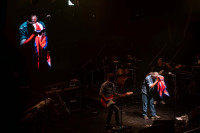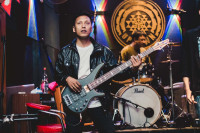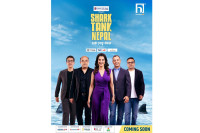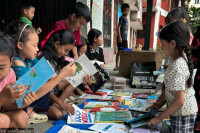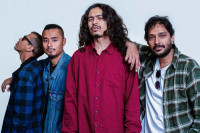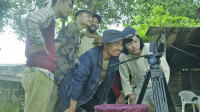Sun, Dec 14, 2025
Entertainment
The literal mind
Muna Gurung is a writer and educator based in New York City. She runs a little high school writing centre where she spends her time bribing young people
bookmark
Ekantipur Report
Published at : February 28, 2014
Muna Gurung is a writer and educator based in New York City. She runs a little high school writing centre where she spends her time bribing young people—with sugary treats—to build a love and culture of writing. Gurung spoke to Prizma Ghimire about her love of reading and the books that have inspired her.
How did you first come to love books?
My first encounter with non-required reading was when I was about 10 and my brother bought me a Roald Dahl book: The Witches. I remember memorising the traits of said witches and knew that the one trait that would mark a witch in the Singaporean heat was gloved hands. For why would a non-witchy person cover their hands in 30-degree weather? When I finally encountered a woman wearing gloves, I froze from fear. I marvel and miss that literal mind. After some Dahl books, I didn’t really read as voraciously as I would like to imagine. But I grew up with my mother and my brother speaking to me in stories. It wasn’t until my family moved to Kathmandu and I began to read fiction in school that I got back to reading.
Who are your favorite authors?
I love Arundhati Roy. And then, I love many others: bell hooks, Victor LaValle, Jeanette Winterson, Flannery O’Connor, Eudora Welty, James Baldwin, Anton Chekov, David Sedaris, Martha Nussbaum, Allison Bechdel etc etc. New authors? Why yes! Prawin Adhikari’s Mortality Sutra in The Kathmandu Post was beautiful and I’m excited for his new collection of short stories. Also, I’m finally reading Nicole Krauss’ History of Love and boy is she talented!
Which book do you think is a must-read? Why?
Every year, without fail, I re-read The God of Small Things. In 1998, I was climbing trees, picking plums, making up crazy stories in a large magical garden that belonged to an old friend of mine, Monica. She was well read, smart and an amazing writer. That summer, she was reading The God of Small Things and told me how the novel was unlike any story she had read before. I didn’t pick it up until the following year because I somehow convinced myself that it would take me at least a year to mature up to her reading level. When I read the novel, I was surprised by Roy’s sophisticated prose delivered in generous and accessible ways. She was also one of the first non-Western writers I read and my teenage head exploded; I couldn’t believe that stories like ours could be told in the written form. It is because of women like Monica and Roy that I wanted to write.
What is good writing for you? What makes a good writer?
Good writing is generous writing that is aware of the reader. One that doesn’t talk down to the reader but also doesn’t lose the reader in a whirlpool of fancy words and tricks. A good writer is someone who is open to feedback, rewrites more than they write and always, always listens and reads in multi literate ways.
Do you update yourself with Nepali literature?
Unfortunately, I’ve been terrible at keeping up with Nepali literature. Although I feel pretty updated with Nepali writers writing in English, I still find myself in the first few pages of Amar Neupane’s Seto Dharti that I started months ago.
Are you planning to come up with a literary work of your own anytime soon?
Well, theoretically, I’m working on something. Sometimes teaching can be so falsely satisfying and tangible. One can make lesson plans, teach, grade papers and feel so accomplished. That rush of satisfaction comes easier than, say, going back to the drawing board to play with that non-existent novel that can’t figure out what it wants to be.
Do you think the art of reading a book will ever be replaced by more modern forms of entertainment?
I don’t know about “the art of reading a book” but I think the ways in which we read will diversify. We have already begun and will continue to read in myriad ways and find that things such as eBooks will change and expand our reading experiences and the way we consume books. When I first encountered the YA novel Chopsticks by Jessica Anthony and Rodrigo Corral, it blew me away. I was reading both images and words arranged in a purposeful manner to tell a specific story. The eBook version was even more exciting as I was able listen to audio, watch videos, and be a voyeur on instant messaging screens all within digital pages of the novel. While some of my students were drawn to the digital version, others still preferred to read the physical book.
Advice for young readers?
I’d say read all sorts of things: Tweets, blog posts, Facebook statuses, emails, graphic novels, love letters, stories, essays, recipes, lyrics. But don’t get caught up in reading only the written/printed word; be a reader of images, be a reader of stories your mother tells you or the chores your sister lists out, or the complaints your brother has, or the phone conversations of passengers in your tempo rides, the ever-changing billboards along the Bagmati bridge or the walls of art that has taken over Kathmandu. You are reading all the time. If we are aware of that, the culture of reading won’t feel so foreign and we will naturally be critical readers and responsible consumers.
Editor's Picks
Public savings at risk as debt-ridden Nepal Airlines’ finances spiral
Hypertension and diabetes driving eye crisis in Kathmandu Valley
Bureaucratic hurdles, legal failures force father and daughter to take their own lives
Record graft case filed over China-funded Pokhara airport
Drone helps farmers tackle old challenges
E-PAPER | December 14, 2025
×




 9.12°C Kathmandu
9.12°C Kathmandu